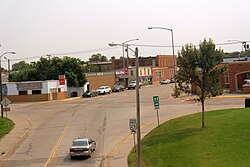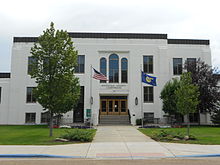Wolf Point | |
|---|---|
 Downtown Wolf Point | |
 Location of Wolf Point, Montana | |
| Coordinates: 48°05′35″N105°38′29″W / 48.09306°N 105.64139°W | |
| Country | United States |
| State | Montana |
| County | Roosevelt |
| Incorporated (city) | 1915 |
| Government | |
| • Type | Tribal |
| Area | |
• Total | 0.88 sq mi (2.29 km2) |
| • Land | 0.88 sq mi (2.29 km2) |
| • Water | 0.00 sq mi (0.00 km2) |
| Elevation | 2,001 ft (610 m) |
| Population (2020) | |
• Total | 2,517 |
| • Density | 2,850.51/sq mi (1,100.95/km2) |
| Time zone | UTC−7 (Mountain Standard Time (MST)) |
| • Summer (DST) | UTC−6 (Mountain Daylight Time (MDT)) |
| ZIP code | 59201 |
| Area code | 406 |
| FIPS code | 30-81475 |
| GNIS feature ID | 2412291 [2] |
| Website | http://ci.wolf-point.mt.us/ |
Wolf Point is a city in and the county seat of Roosevelt County, Montana, United States. [3] The population was 2,517 at the 2020 census, down 4% from 2,621 in the 2010 Census. [4] It is the largest community on the Fort Peck Indian Reservation. Wolf Point is the home of the annual Wild Horse Stampede, held every year during the second weekend of July. Wolf Point's Wild Horse Stampede is the oldest rodeo in Montana, and has been called the "Grandaddy of Montana Rodeos". [5] [6] [7]
Contents
- History
- Geography
- Topography
- Climate
- Demographics
- 2010 census
- 2000 census
- Arts and culture
- Attractions
- Library
- Government
- Mayors
- Education
- K-12
- College
- Media
- Infrastructure
- Transportation
- Medical facilities
- Notable people
- References in literature
- See also
- References
- Further reading
- External links
Wolf Point also is home of the Wadopana Pow-wow, the oldest traditional pow wow in Montana and always held the first week in August. [8]




